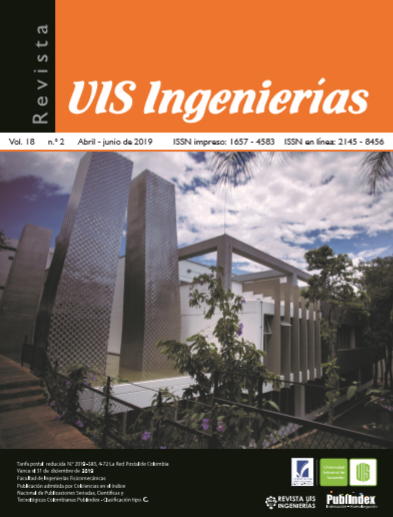Dissimilar joints of the aluminum alloy AA7075 – T6 and high-density polyethylene (HDPE) obtained by Friction Stir Welding (FSW)
Published 2019-02-06
Keywords
- Friction Stir Welding,
- dissimilar welds,
- AA7075-T6,
- HDPE
How to Cite
Abstract
In this work, the solid-state process of Friction Stir Welding (FSW) was employed due to its ability to obtain permanent joints without surpassing the fusion temperatures of the base materials involved and being free of filler material. Its characteristics make it a satisfactory process for bonding dissimilar materials, specifically the aluminum alloy AA7075 – T6 and high-density polyethylene (HDPE). This alloy is commonly used in the aerospace industry and other high – demanding mechanical applications because of its properties, making it ideal for FSW as it presents low weldability by traditional methods like arc welding processes. Aluminum and polymer joints are presented as an alternative for the fabrication of components with high weight resistance ratio.
For the welds, base material plates of 50X150mm and 3/16 in thick, a CNC machine equipped with a longitudinal and radial force measuring device and a non-consumable H13 tool with a concave shoulder and concentric circles with a 4.5 mm threaded pin were used. The parameters selected range from 500 to 2450 RPMand from 25 to 100 mm/min for the spindle and travel speed, respectively. Non-destructive tests (NDT) of visual inspection and dye penetrant were used on the welds to evaluatie the quality. Additionally, joints were sectioned and inspected employing optical stereoscopy after obtaining probes by water jet cut, looking for the level of continuity in the region of welding. This information was compared with force data and destructive tests results.
Additionally, water jet cutting was used, seeking the lowest affectation level to obtain sound specimens and compare the level of continuity in the cross-section of the joints, using optical stereoscopy. As a complement to the inspection techniques, the results were compared with longitudinal and axial force data and the mechanical behavior of some joints.
The cross-section of the welds had greater continuity and better performance using the following parameters combinations: 50 mm/min and between 1150 to 2450 RPM and the combination of 75 mm/min and 2450 RPM. Obtaining sound joints is promising but still in development.
Downloads
References
A. R. Patel, C. G. Dalwadi, and H. G. Rana, “A Review: Dissimilar Material Joining of Metal to Polymer using Friction Stir Welding (FSW),” IJSTE -International J. Sci. Technol. Eng., vol. 2, no. 10, pp. 702–706, 2016.
K. Martinsen, S. J. Hu, and B. E. Carlson, “Joining of dissimilar materials,” CIRP Ann. - Manuf. Technol., vol. 64, no. 2, pp. 679–699, 2015.
F. Khodabakhshi et al., “Microstructure-property characterization of a friction-stir welded joint between AA5059 aluminum alloy and high density polyethylene,” Mater. Charact., vol. 98, no. July 2016, pp. 73–82, 2014.
D. S. Villa-salazar, D. A. Hincapié-zuluaga, M. Sc, and C. Física, “Herramientas usadas en soldadura por fricción-agitación Computer Simulation of Heat Transfer on Tools Used in Friction Stir Welding,” vol. 26, no. 2, 2015.
MakeItFrom, “7075-T6 Aluminum,” 2018. [Online]. Available: https://www.makeitfrom.com/material-properties/7075-T6-Aluminum. [Accessed: 02-Feb-2018].
D. Fu, C. Sun, C. Zhang, and J. Liu, “Improvement of Formation Quality for Friction Stir Welded Joints,” Weld. J., vol. 91, no. Welding research, pp. 169–173, 2012.
B. plastic Federation, “Polyethylene (High Density) HDPE,” British Plastic Federation, 2018. .
A. Plastics, “High-density poluethylene,” 2018.
MatWeb, “Aluminum 7075-T6; 7075-T651,” 2018. [Online]. Available: http://www.matweb.com/search/DataSheet.aspx?MatGUID=4f19a42be94546b686bbf43f79c51b7d&ckck=1. [Accessed: 02-Feb-2018].
U. de Barcelona, “Polietileno de alta densidad,” Materials, 2018. [Online]. Available: http://www.ub.edu/cmematerials/es/content/polietileno-de-alta-densidad.
E. Azarsa and A. Mostafapour, “Experimental investigation on flexural behavior of friction stir welded high density polyethylene sheets,” J. Manuf. Process., vol. 16, no. 1, pp. 149–155, 2014.
F. Simões and D. M. Rodrigues, “Material flow and thermo-mechanical conditions during Friction Stir Welding of polymers: Literature review, experimental results and empirical analysis,” Mater. Des., vol. 59, pp. 344–351, 2014.
W. Ratanathavorn, “Hybrid Joining of Aluminum to Thermoplastics with Friction Stir Welding,” KTH-Royal Institute of Technology, 2012.
B. C. Liechty and B. W. Webb, “The use of plasticine as an analog to explore material flow in friction stir welding,” J. Mater. Process. Technol., vol. 184, no. 1–3, pp. 240–250, 2007.
B. Vijendra and A. Sharma, “Induction heated tool assisted friction-stir welding (i-FSW): A novel hybrid process for joining of thermoplastics,” J. Manuf. Process., vol. 20, pp. 234–244, 2015.
S. Eslami, T. Ramos, P. J. Tavares, and P. M. G. P. Moreira, “Shoulder design developments for FSW lap joints of dissimilar polymers,” J. Manuf. Process., vol. 20, pp. 15–23, 2015.
American Welding Society, AWS D17.3, Specification for Friction Stir Welding of Aluminum Alloys for Aerospace Applications, 1st ed. Miami, FL, 2009.
ISO, “ISO 25239-1:2011: Friction stir welding — Aluminium Part 1: Quality and inspection requirements,” BSI Stand. Publ., 2011.
N. Busu, M. S. Jaffarullah, C. Y. Low, M. S. B. Shaari, Armansyah, and A. Jaffar, “A Review of Force Control Techniques in Friction Stir Process,” Procedia Comput. Sci., vol. 76, no. Iris, pp. 528–533, 2015.
ASTM International, ASTM E8 / E8M-13, Standard Test Methods for Tension Testing of Metallic Materials, vol. 2. 2013.

